Business Law: Negligence and Ethical Decision Making
VerifiedAdded on 2023/06/12
|12
|2896
|243
AI Summary
This article discusses the concept of negligence in business law and its essential elements. It also provides an ethical decision-making framework for a scenario involving an unsafe sculpture in an art gallery. The article covers the Caparo test, the objective test, the But for test, and the Wagon Mound case. It also discusses contributory negligence and its essentials. The subject is Business Law, and the course code is not mentioned. The article is relevant to students studying business law in any college or university.
Contribute Materials
Your contribution can guide someone’s learning journey. Share your
documents today.
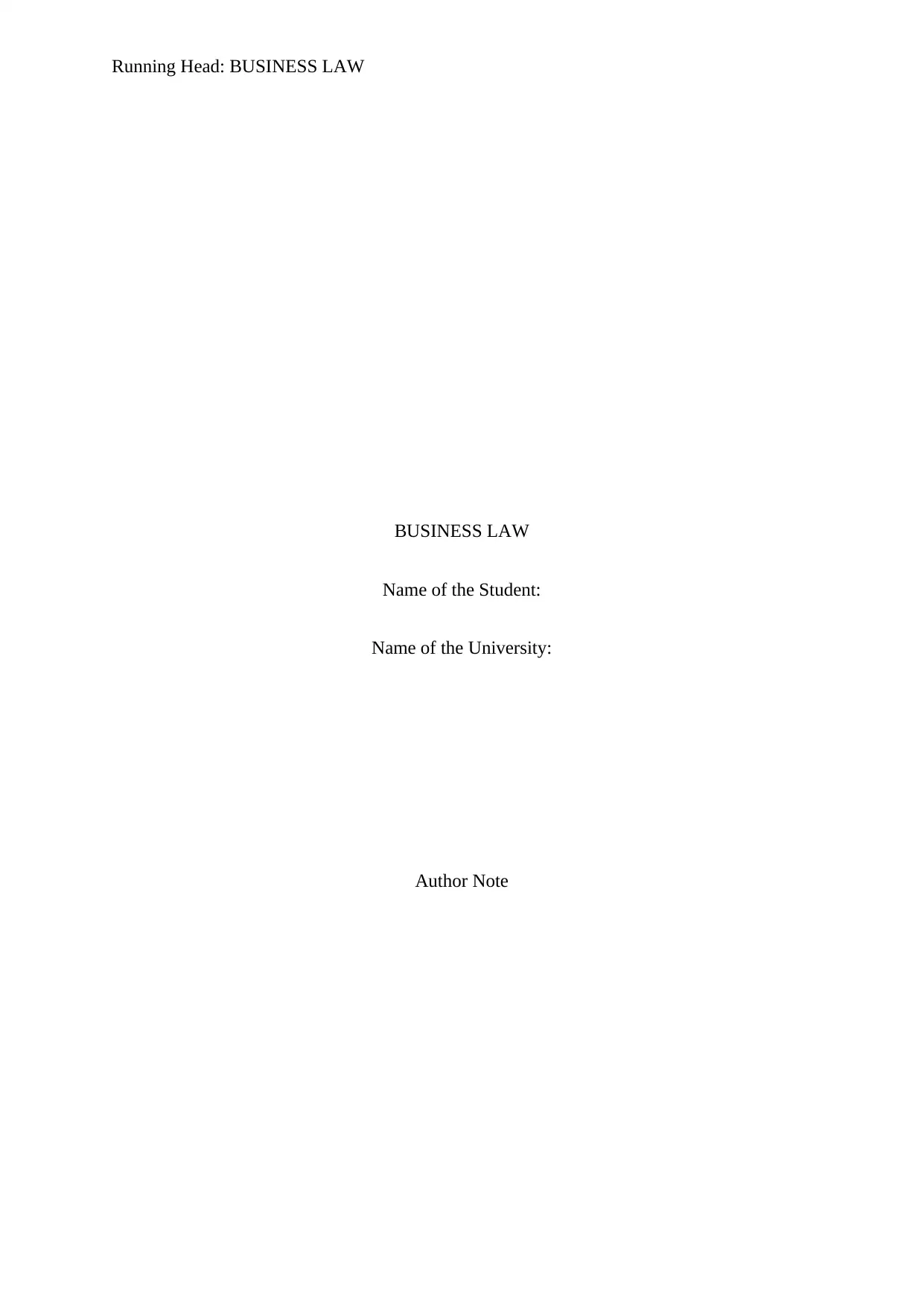
Running Head: BUSINESS LAW
BUSINESS LAW
Name of the Student:
Name of the University:
Author Note
BUSINESS LAW
Name of the Student:
Name of the University:
Author Note
Secure Best Marks with AI Grader
Need help grading? Try our AI Grader for instant feedback on your assignments.
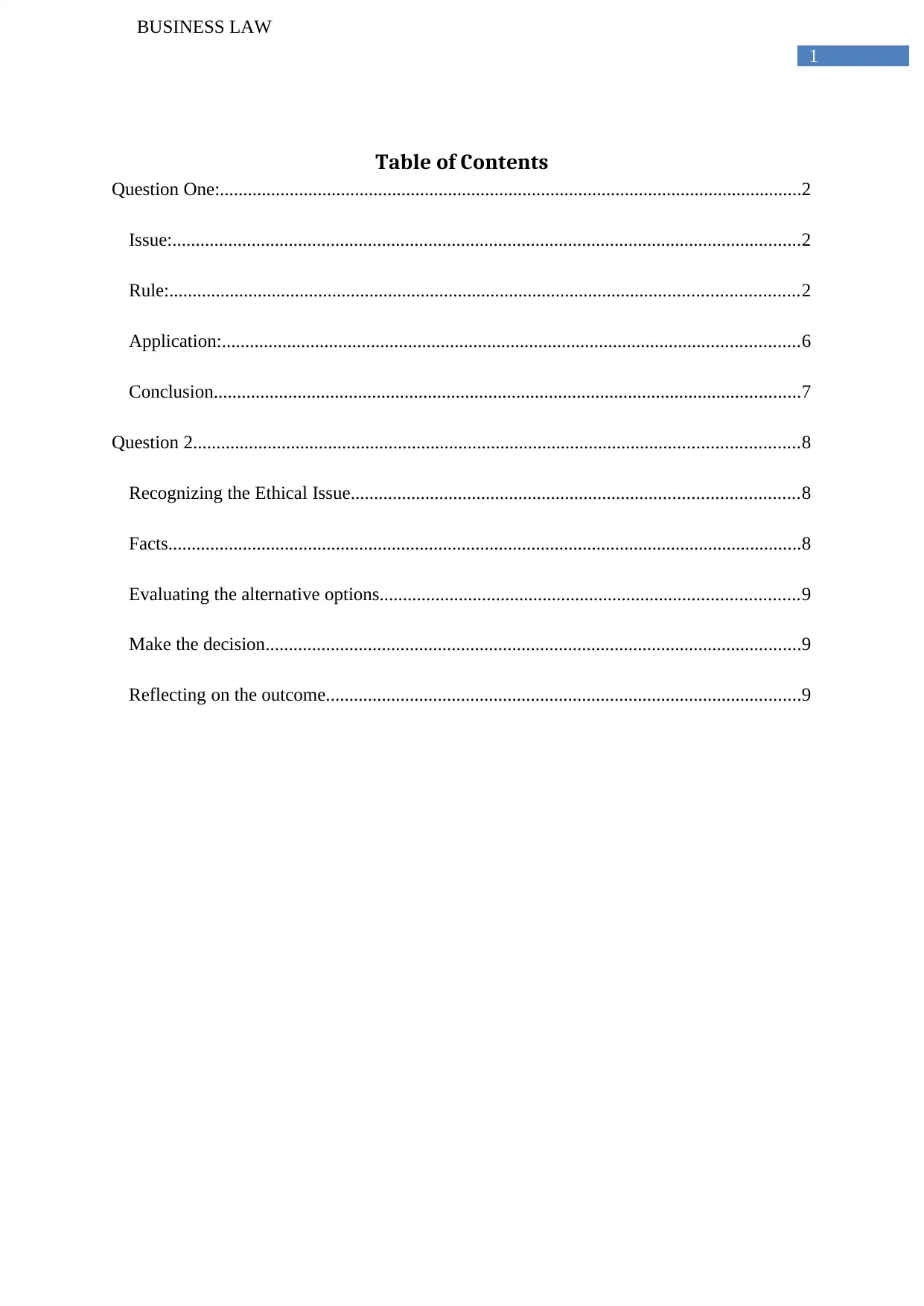
1
BUSINESS LAW
Table of Contents
Question One:.............................................................................................................................2
Issue:.......................................................................................................................................2
Rule:.......................................................................................................................................2
Application:............................................................................................................................6
Conclusion..............................................................................................................................7
Question 2..................................................................................................................................8
Recognizing the Ethical Issue................................................................................................8
Facts........................................................................................................................................8
Evaluating the alternative options..........................................................................................9
Make the decision...................................................................................................................9
Reflecting on the outcome......................................................................................................9
BUSINESS LAW
Table of Contents
Question One:.............................................................................................................................2
Issue:.......................................................................................................................................2
Rule:.......................................................................................................................................2
Application:............................................................................................................................6
Conclusion..............................................................................................................................7
Question 2..................................................................................................................................8
Recognizing the Ethical Issue................................................................................................8
Facts........................................................................................................................................8
Evaluating the alternative options..........................................................................................9
Make the decision...................................................................................................................9
Reflecting on the outcome......................................................................................................9
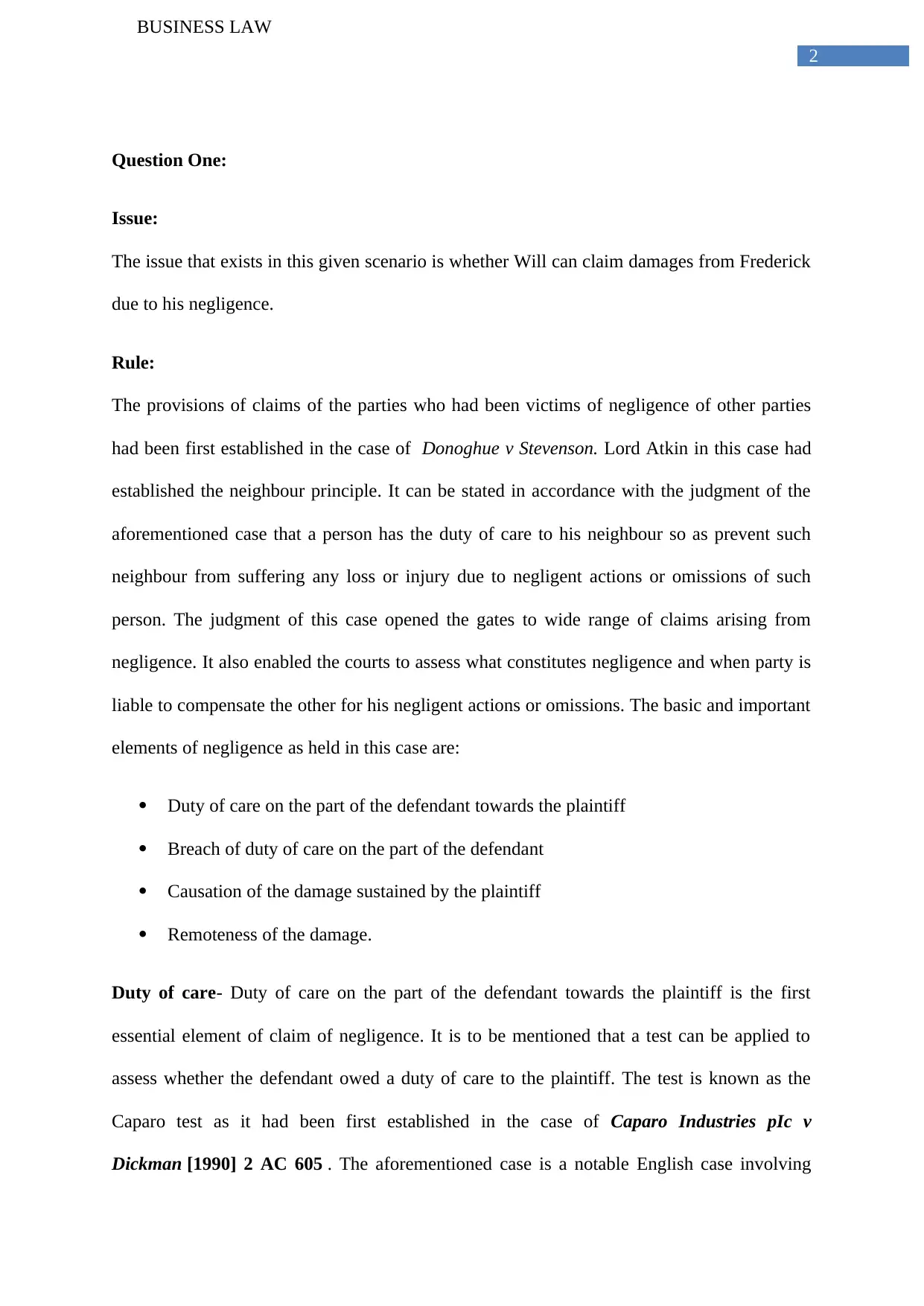
2
BUSINESS LAW
Question One:
Issue:
The issue that exists in this given scenario is whether Will can claim damages from Frederick
due to his negligence.
Rule:
The provisions of claims of the parties who had been victims of negligence of other parties
had been first established in the case of Donoghue v Stevenson. Lord Atkin in this case had
established the neighbour principle. It can be stated in accordance with the judgment of the
aforementioned case that a person has the duty of care to his neighbour so as prevent such
neighbour from suffering any loss or injury due to negligent actions or omissions of such
person. The judgment of this case opened the gates to wide range of claims arising from
negligence. It also enabled the courts to assess what constitutes negligence and when party is
liable to compensate the other for his negligent actions or omissions. The basic and important
elements of negligence as held in this case are:
Duty of care on the part of the defendant towards the plaintiff
Breach of duty of care on the part of the defendant
Causation of the damage sustained by the plaintiff
Remoteness of the damage.
Duty of care- Duty of care on the part of the defendant towards the plaintiff is the first
essential element of claim of negligence. It is to be mentioned that a test can be applied to
assess whether the defendant owed a duty of care to the plaintiff. The test is known as the
Caparo test as it had been first established in the case of Caparo Industries pIc v
Dickman [1990] 2 AC 605 . The aforementioned case is a notable English case involving
BUSINESS LAW
Question One:
Issue:
The issue that exists in this given scenario is whether Will can claim damages from Frederick
due to his negligence.
Rule:
The provisions of claims of the parties who had been victims of negligence of other parties
had been first established in the case of Donoghue v Stevenson. Lord Atkin in this case had
established the neighbour principle. It can be stated in accordance with the judgment of the
aforementioned case that a person has the duty of care to his neighbour so as prevent such
neighbour from suffering any loss or injury due to negligent actions or omissions of such
person. The judgment of this case opened the gates to wide range of claims arising from
negligence. It also enabled the courts to assess what constitutes negligence and when party is
liable to compensate the other for his negligent actions or omissions. The basic and important
elements of negligence as held in this case are:
Duty of care on the part of the defendant towards the plaintiff
Breach of duty of care on the part of the defendant
Causation of the damage sustained by the plaintiff
Remoteness of the damage.
Duty of care- Duty of care on the part of the defendant towards the plaintiff is the first
essential element of claim of negligence. It is to be mentioned that a test can be applied to
assess whether the defendant owed a duty of care to the plaintiff. The test is known as the
Caparo test as it had been first established in the case of Caparo Industries pIc v
Dickman [1990] 2 AC 605 . The aforementioned case is a notable English case involving
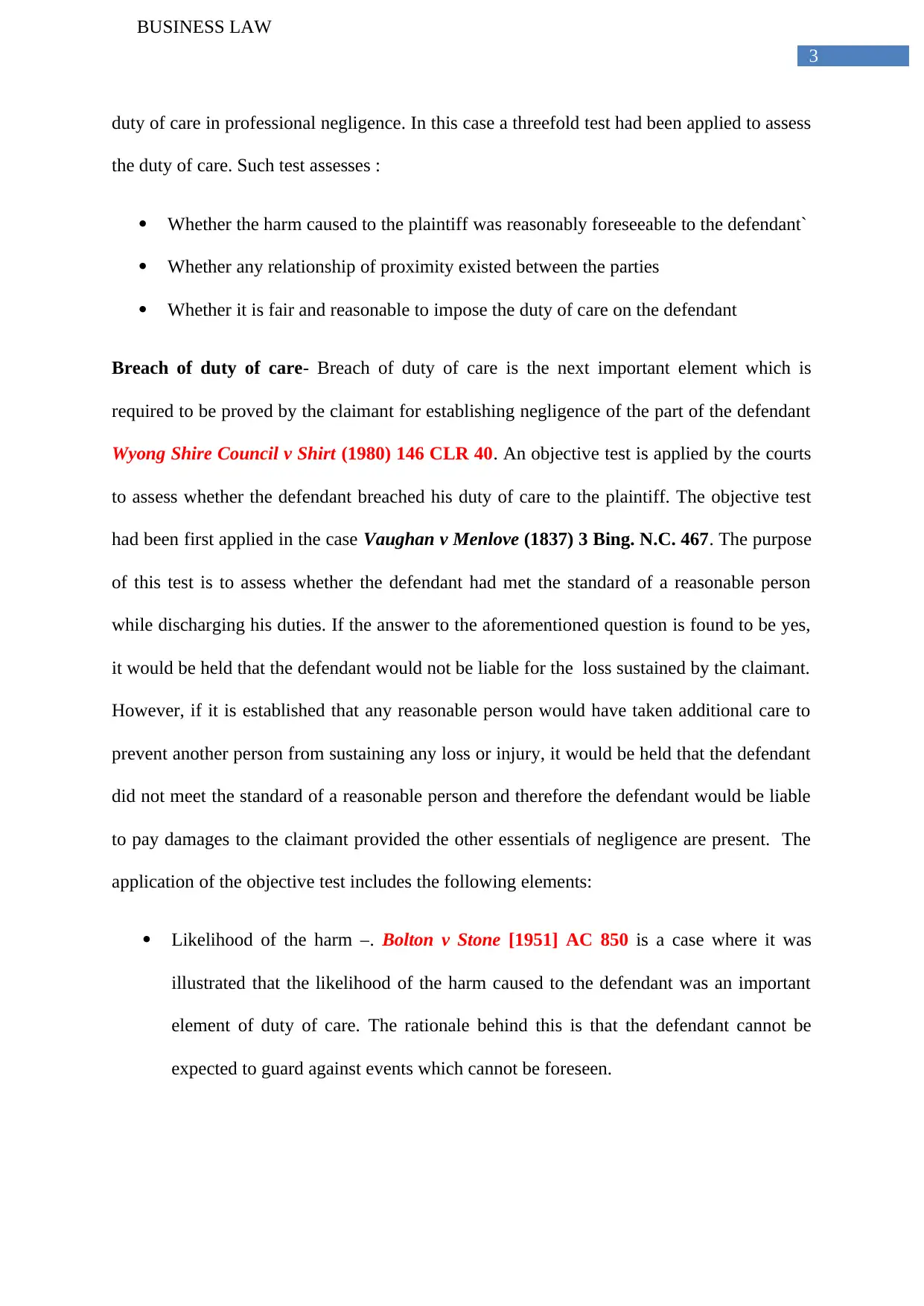
3
BUSINESS LAW
duty of care in professional negligence. In this case a threefold test had been applied to assess
the duty of care. Such test assesses :
Whether the harm caused to the plaintiff was reasonably foreseeable to the defendant`
Whether any relationship of proximity existed between the parties
Whether it is fair and reasonable to impose the duty of care on the defendant
Breach of duty of care- Breach of duty of care is the next important element which is
required to be proved by the claimant for establishing negligence of the part of the defendant
Wyong Shire Council v Shirt (1980) 146 CLR 40. An objective test is applied by the courts
to assess whether the defendant breached his duty of care to the plaintiff. The objective test
had been first applied in the case Vaughan v Menlove (1837) 3 Bing. N.C. 467. The purpose
of this test is to assess whether the defendant had met the standard of a reasonable person
while discharging his duties. If the answer to the aforementioned question is found to be yes,
it would be held that the defendant would not be liable for the loss sustained by the claimant.
However, if it is established that any reasonable person would have taken additional care to
prevent another person from sustaining any loss or injury, it would be held that the defendant
did not meet the standard of a reasonable person and therefore the defendant would be liable
to pay damages to the claimant provided the other essentials of negligence are present. The
application of the objective test includes the following elements:
Likelihood of the harm –. Bolton v Stone [1951] AC 850 is a case where it was
illustrated that the likelihood of the harm caused to the defendant was an important
element of duty of care. The rationale behind this is that the defendant cannot be
expected to guard against events which cannot be foreseen.
BUSINESS LAW
duty of care in professional negligence. In this case a threefold test had been applied to assess
the duty of care. Such test assesses :
Whether the harm caused to the plaintiff was reasonably foreseeable to the defendant`
Whether any relationship of proximity existed between the parties
Whether it is fair and reasonable to impose the duty of care on the defendant
Breach of duty of care- Breach of duty of care is the next important element which is
required to be proved by the claimant for establishing negligence of the part of the defendant
Wyong Shire Council v Shirt (1980) 146 CLR 40. An objective test is applied by the courts
to assess whether the defendant breached his duty of care to the plaintiff. The objective test
had been first applied in the case Vaughan v Menlove (1837) 3 Bing. N.C. 467. The purpose
of this test is to assess whether the defendant had met the standard of a reasonable person
while discharging his duties. If the answer to the aforementioned question is found to be yes,
it would be held that the defendant would not be liable for the loss sustained by the claimant.
However, if it is established that any reasonable person would have taken additional care to
prevent another person from sustaining any loss or injury, it would be held that the defendant
did not meet the standard of a reasonable person and therefore the defendant would be liable
to pay damages to the claimant provided the other essentials of negligence are present. The
application of the objective test includes the following elements:
Likelihood of the harm –. Bolton v Stone [1951] AC 850 is a case where it was
illustrated that the likelihood of the harm caused to the defendant was an important
element of duty of care. The rationale behind this is that the defendant cannot be
expected to guard against events which cannot be foreseen.
Secure Best Marks with AI Grader
Need help grading? Try our AI Grader for instant feedback on your assignments.
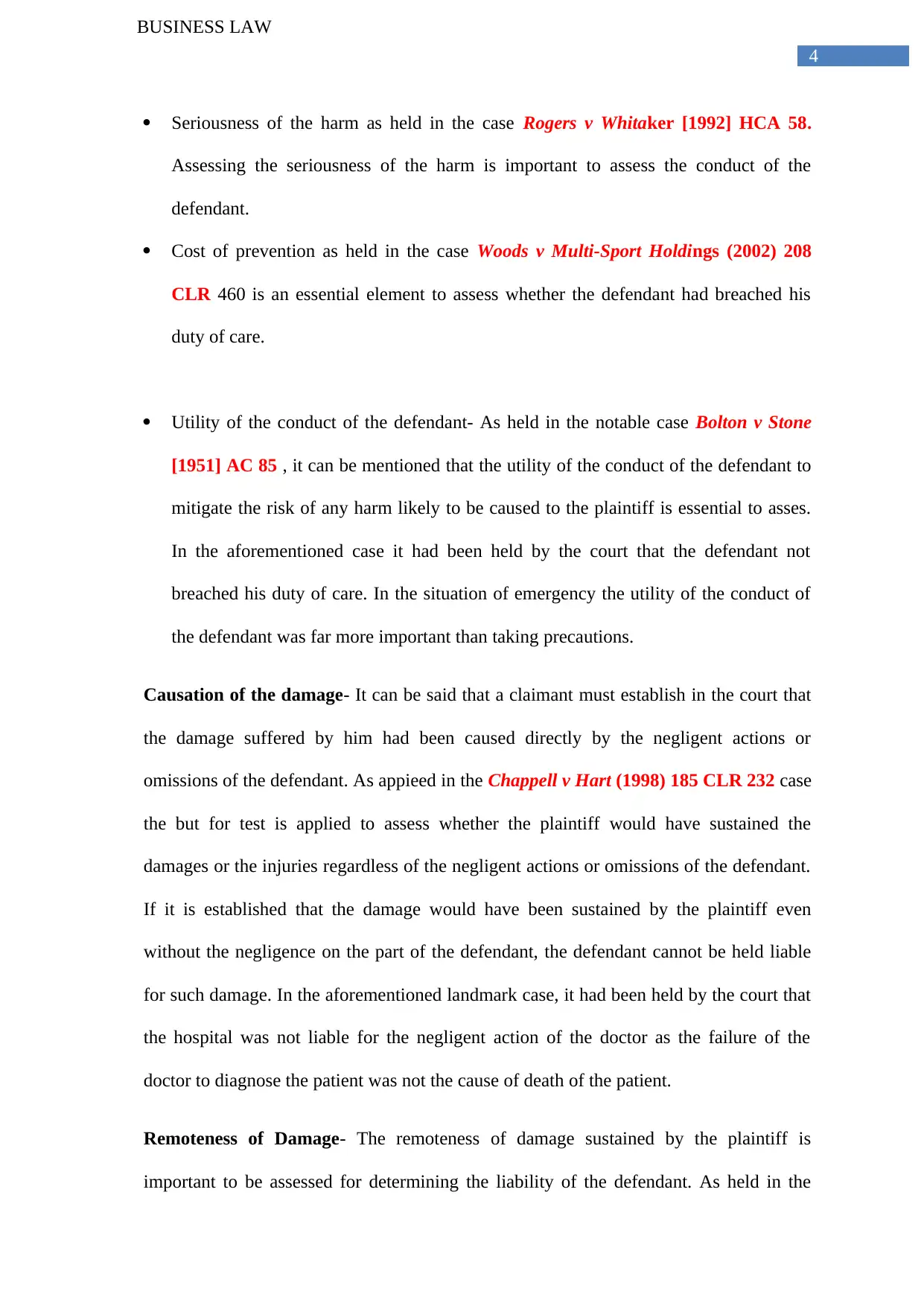
4
BUSINESS LAW
Seriousness of the harm as held in the case Rogers v Whitaker [1992] HCA 58.
Assessing the seriousness of the harm is important to assess the conduct of the
defendant.
Cost of prevention as held in the case Woods v Multi-Sport Holdings (2002) 208
CLR 460 is an essential element to assess whether the defendant had breached his
duty of care.
Utility of the conduct of the defendant- As held in the notable case Bolton v Stone
[1951] AC 85 , it can be mentioned that the utility of the conduct of the defendant to
mitigate the risk of any harm likely to be caused to the plaintiff is essential to asses.
In the aforementioned case it had been held by the court that the defendant not
breached his duty of care. In the situation of emergency the utility of the conduct of
the defendant was far more important than taking precautions.
Causation of the damage- It can be said that a claimant must establish in the court that
the damage suffered by him had been caused directly by the negligent actions or
omissions of the defendant. As appieed in the Chappell v Hart (1998) 185 CLR 232 case
the but for test is applied to assess whether the plaintiff would have sustained the
damages or the injuries regardless of the negligent actions or omissions of the defendant.
If it is established that the damage would have been sustained by the plaintiff even
without the negligence on the part of the defendant, the defendant cannot be held liable
for such damage. In the aforementioned landmark case, it had been held by the court that
the hospital was not liable for the negligent action of the doctor as the failure of the
doctor to diagnose the patient was not the cause of death of the patient.
Remoteness of Damage- The remoteness of damage sustained by the plaintiff is
important to be assessed for determining the liability of the defendant. As held in the
BUSINESS LAW
Seriousness of the harm as held in the case Rogers v Whitaker [1992] HCA 58.
Assessing the seriousness of the harm is important to assess the conduct of the
defendant.
Cost of prevention as held in the case Woods v Multi-Sport Holdings (2002) 208
CLR 460 is an essential element to assess whether the defendant had breached his
duty of care.
Utility of the conduct of the defendant- As held in the notable case Bolton v Stone
[1951] AC 85 , it can be mentioned that the utility of the conduct of the defendant to
mitigate the risk of any harm likely to be caused to the plaintiff is essential to asses.
In the aforementioned case it had been held by the court that the defendant not
breached his duty of care. In the situation of emergency the utility of the conduct of
the defendant was far more important than taking precautions.
Causation of the damage- It can be said that a claimant must establish in the court that
the damage suffered by him had been caused directly by the negligent actions or
omissions of the defendant. As appieed in the Chappell v Hart (1998) 185 CLR 232 case
the but for test is applied to assess whether the plaintiff would have sustained the
damages or the injuries regardless of the negligent actions or omissions of the defendant.
If it is established that the damage would have been sustained by the plaintiff even
without the negligence on the part of the defendant, the defendant cannot be held liable
for such damage. In the aforementioned landmark case, it had been held by the court that
the hospital was not liable for the negligent action of the doctor as the failure of the
doctor to diagnose the patient was not the cause of death of the patient.
Remoteness of Damage- The remoteness of damage sustained by the plaintiff is
important to be assessed for determining the liability of the defendant. As held in the
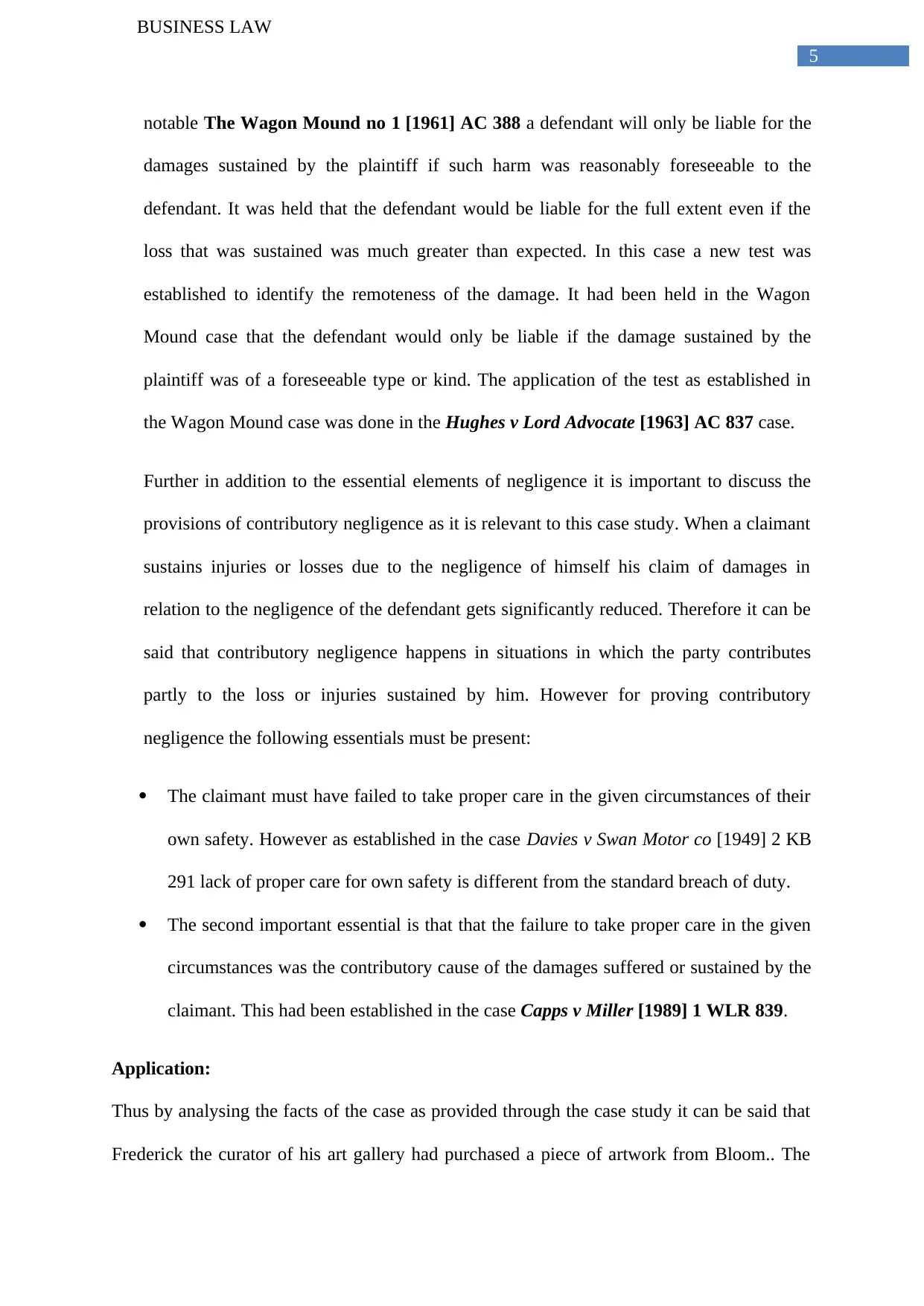
5
BUSINESS LAW
notable The Wagon Mound no 1 [1961] AC 388 a defendant will only be liable for the
damages sustained by the plaintiff if such harm was reasonably foreseeable to the
defendant. It was held that the defendant would be liable for the full extent even if the
loss that was sustained was much greater than expected. In this case a new test was
established to identify the remoteness of the damage. It had been held in the Wagon
Mound case that the defendant would only be liable if the damage sustained by the
plaintiff was of a foreseeable type or kind. The application of the test as established in
the Wagon Mound case was done in the Hughes v Lord Advocate [1963] AC 837 case.
Further in addition to the essential elements of negligence it is important to discuss the
provisions of contributory negligence as it is relevant to this case study. When a claimant
sustains injuries or losses due to the negligence of himself his claim of damages in
relation to the negligence of the defendant gets significantly reduced. Therefore it can be
said that contributory negligence happens in situations in which the party contributes
partly to the loss or injuries sustained by him. However for proving contributory
negligence the following essentials must be present:
The claimant must have failed to take proper care in the given circumstances of their
own safety. However as established in the case Davies v Swan Motor co [1949] 2 KB
291 lack of proper care for own safety is different from the standard breach of duty.
The second important essential is that that the failure to take proper care in the given
circumstances was the contributory cause of the damages suffered or sustained by the
claimant. This had been established in the case Capps v Miller [1989] 1 WLR 839.
Application:
Thus by analysing the facts of the case as provided through the case study it can be said that
Frederick the curator of his art gallery had purchased a piece of artwork from Bloom.. The
BUSINESS LAW
notable The Wagon Mound no 1 [1961] AC 388 a defendant will only be liable for the
damages sustained by the plaintiff if such harm was reasonably foreseeable to the
defendant. It was held that the defendant would be liable for the full extent even if the
loss that was sustained was much greater than expected. In this case a new test was
established to identify the remoteness of the damage. It had been held in the Wagon
Mound case that the defendant would only be liable if the damage sustained by the
plaintiff was of a foreseeable type or kind. The application of the test as established in
the Wagon Mound case was done in the Hughes v Lord Advocate [1963] AC 837 case.
Further in addition to the essential elements of negligence it is important to discuss the
provisions of contributory negligence as it is relevant to this case study. When a claimant
sustains injuries or losses due to the negligence of himself his claim of damages in
relation to the negligence of the defendant gets significantly reduced. Therefore it can be
said that contributory negligence happens in situations in which the party contributes
partly to the loss or injuries sustained by him. However for proving contributory
negligence the following essentials must be present:
The claimant must have failed to take proper care in the given circumstances of their
own safety. However as established in the case Davies v Swan Motor co [1949] 2 KB
291 lack of proper care for own safety is different from the standard breach of duty.
The second important essential is that that the failure to take proper care in the given
circumstances was the contributory cause of the damages suffered or sustained by the
claimant. This had been established in the case Capps v Miller [1989] 1 WLR 839.
Application:
Thus by analysing the facts of the case as provided through the case study it can be said that
Frederick the curator of his art gallery had purchased a piece of artwork from Bloom.. The
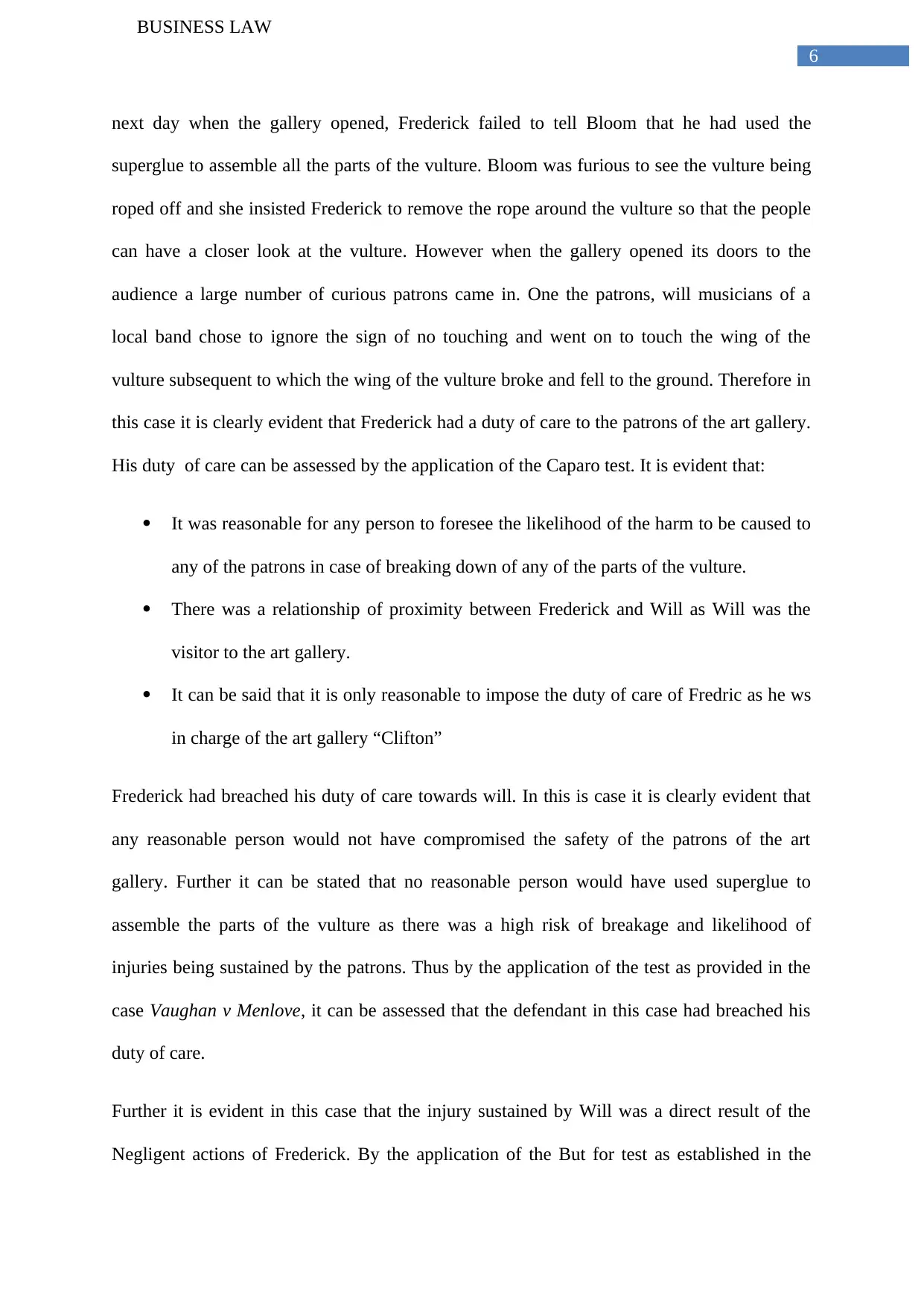
6
BUSINESS LAW
next day when the gallery opened, Frederick failed to tell Bloom that he had used the
superglue to assemble all the parts of the vulture. Bloom was furious to see the vulture being
roped off and she insisted Frederick to remove the rope around the vulture so that the people
can have a closer look at the vulture. However when the gallery opened its doors to the
audience a large number of curious patrons came in. One the patrons, will musicians of a
local band chose to ignore the sign of no touching and went on to touch the wing of the
vulture subsequent to which the wing of the vulture broke and fell to the ground. Therefore in
this case it is clearly evident that Frederick had a duty of care to the patrons of the art gallery.
His duty of care can be assessed by the application of the Caparo test. It is evident that:
It was reasonable for any person to foresee the likelihood of the harm to be caused to
any of the patrons in case of breaking down of any of the parts of the vulture.
There was a relationship of proximity between Frederick and Will as Will was the
visitor to the art gallery.
It can be said that it is only reasonable to impose the duty of care of Fredric as he ws
in charge of the art gallery “Clifton”
Frederick had breached his duty of care towards will. In this is case it is clearly evident that
any reasonable person would not have compromised the safety of the patrons of the art
gallery. Further it can be stated that no reasonable person would have used superglue to
assemble the parts of the vulture as there was a high risk of breakage and likelihood of
injuries being sustained by the patrons. Thus by the application of the test as provided in the
case Vaughan v Menlove, it can be assessed that the defendant in this case had breached his
duty of care.
Further it is evident in this case that the injury sustained by Will was a direct result of the
Negligent actions of Frederick. By the application of the But for test as established in the
BUSINESS LAW
next day when the gallery opened, Frederick failed to tell Bloom that he had used the
superglue to assemble all the parts of the vulture. Bloom was furious to see the vulture being
roped off and she insisted Frederick to remove the rope around the vulture so that the people
can have a closer look at the vulture. However when the gallery opened its doors to the
audience a large number of curious patrons came in. One the patrons, will musicians of a
local band chose to ignore the sign of no touching and went on to touch the wing of the
vulture subsequent to which the wing of the vulture broke and fell to the ground. Therefore in
this case it is clearly evident that Frederick had a duty of care to the patrons of the art gallery.
His duty of care can be assessed by the application of the Caparo test. It is evident that:
It was reasonable for any person to foresee the likelihood of the harm to be caused to
any of the patrons in case of breaking down of any of the parts of the vulture.
There was a relationship of proximity between Frederick and Will as Will was the
visitor to the art gallery.
It can be said that it is only reasonable to impose the duty of care of Fredric as he ws
in charge of the art gallery “Clifton”
Frederick had breached his duty of care towards will. In this is case it is clearly evident that
any reasonable person would not have compromised the safety of the patrons of the art
gallery. Further it can be stated that no reasonable person would have used superglue to
assemble the parts of the vulture as there was a high risk of breakage and likelihood of
injuries being sustained by the patrons. Thus by the application of the test as provided in the
case Vaughan v Menlove, it can be assessed that the defendant in this case had breached his
duty of care.
Further it is evident in this case that the injury sustained by Will was a direct result of the
Negligent actions of Frederick. By the application of the But for test as established in the
Paraphrase This Document
Need a fresh take? Get an instant paraphrase of this document with our AI Paraphraser
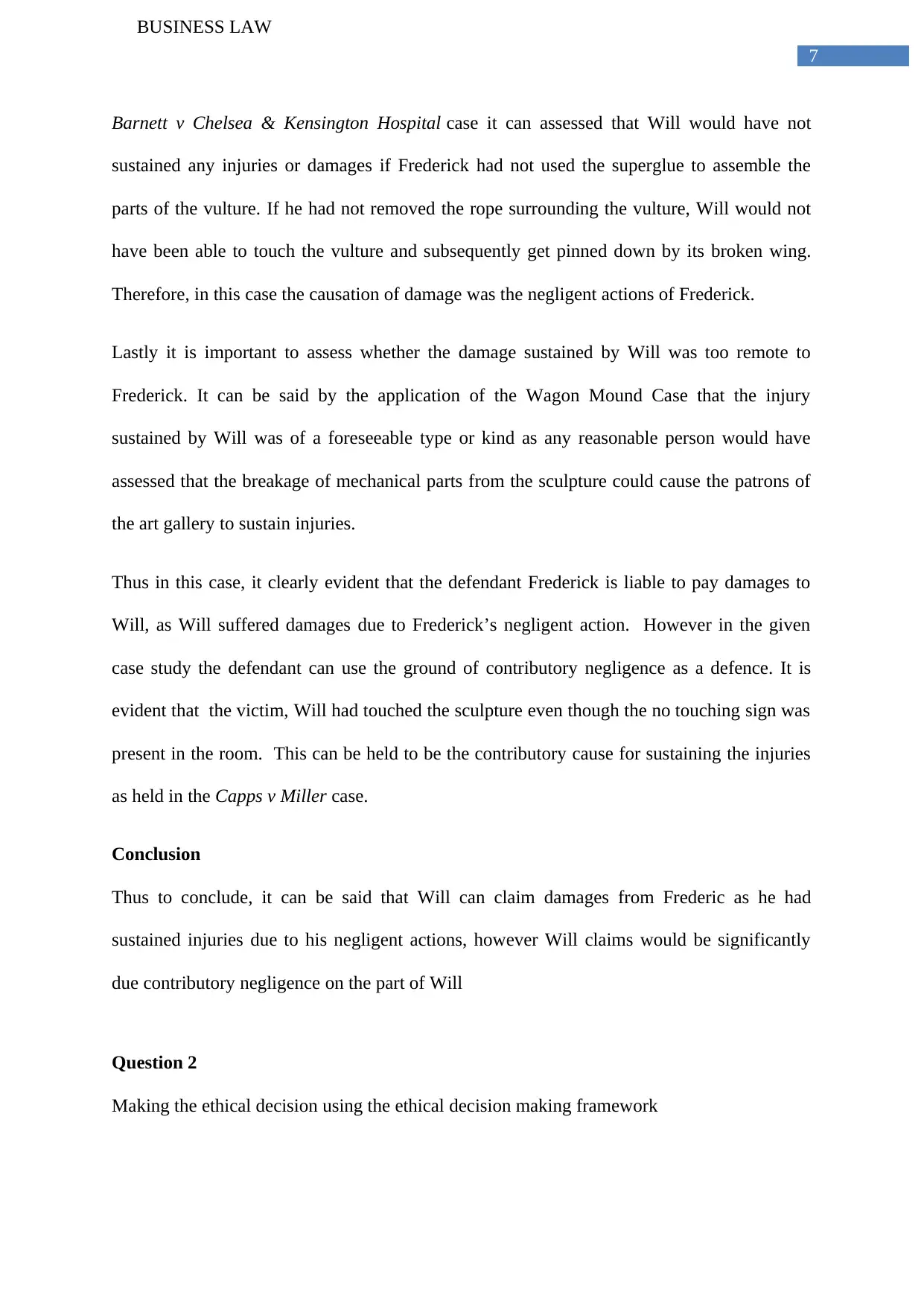
7
BUSINESS LAW
Barnett v Chelsea & Kensington Hospital case it can assessed that Will would have not
sustained any injuries or damages if Frederick had not used the superglue to assemble the
parts of the vulture. If he had not removed the rope surrounding the vulture, Will would not
have been able to touch the vulture and subsequently get pinned down by its broken wing.
Therefore, in this case the causation of damage was the negligent actions of Frederick.
Lastly it is important to assess whether the damage sustained by Will was too remote to
Frederick. It can be said by the application of the Wagon Mound Case that the injury
sustained by Will was of a foreseeable type or kind as any reasonable person would have
assessed that the breakage of mechanical parts from the sculpture could cause the patrons of
the art gallery to sustain injuries.
Thus in this case, it clearly evident that the defendant Frederick is liable to pay damages to
Will, as Will suffered damages due to Frederick’s negligent action. However in the given
case study the defendant can use the ground of contributory negligence as a defence. It is
evident that the victim, Will had touched the sculpture even though the no touching sign was
present in the room. This can be held to be the contributory cause for sustaining the injuries
as held in the Capps v Miller case.
Conclusion
Thus to conclude, it can be said that Will can claim damages from Frederic as he had
sustained injuries due to his negligent actions, however Will claims would be significantly
due contributory negligence on the part of Will
Question 2
Making the ethical decision using the ethical decision making framework
BUSINESS LAW
Barnett v Chelsea & Kensington Hospital case it can assessed that Will would have not
sustained any injuries or damages if Frederick had not used the superglue to assemble the
parts of the vulture. If he had not removed the rope surrounding the vulture, Will would not
have been able to touch the vulture and subsequently get pinned down by its broken wing.
Therefore, in this case the causation of damage was the negligent actions of Frederick.
Lastly it is important to assess whether the damage sustained by Will was too remote to
Frederick. It can be said by the application of the Wagon Mound Case that the injury
sustained by Will was of a foreseeable type or kind as any reasonable person would have
assessed that the breakage of mechanical parts from the sculpture could cause the patrons of
the art gallery to sustain injuries.
Thus in this case, it clearly evident that the defendant Frederick is liable to pay damages to
Will, as Will suffered damages due to Frederick’s negligent action. However in the given
case study the defendant can use the ground of contributory negligence as a defence. It is
evident that the victim, Will had touched the sculpture even though the no touching sign was
present in the room. This can be held to be the contributory cause for sustaining the injuries
as held in the Capps v Miller case.
Conclusion
Thus to conclude, it can be said that Will can claim damages from Frederic as he had
sustained injuries due to his negligent actions, however Will claims would be significantly
due contributory negligence on the part of Will
Question 2
Making the ethical decision using the ethical decision making framework
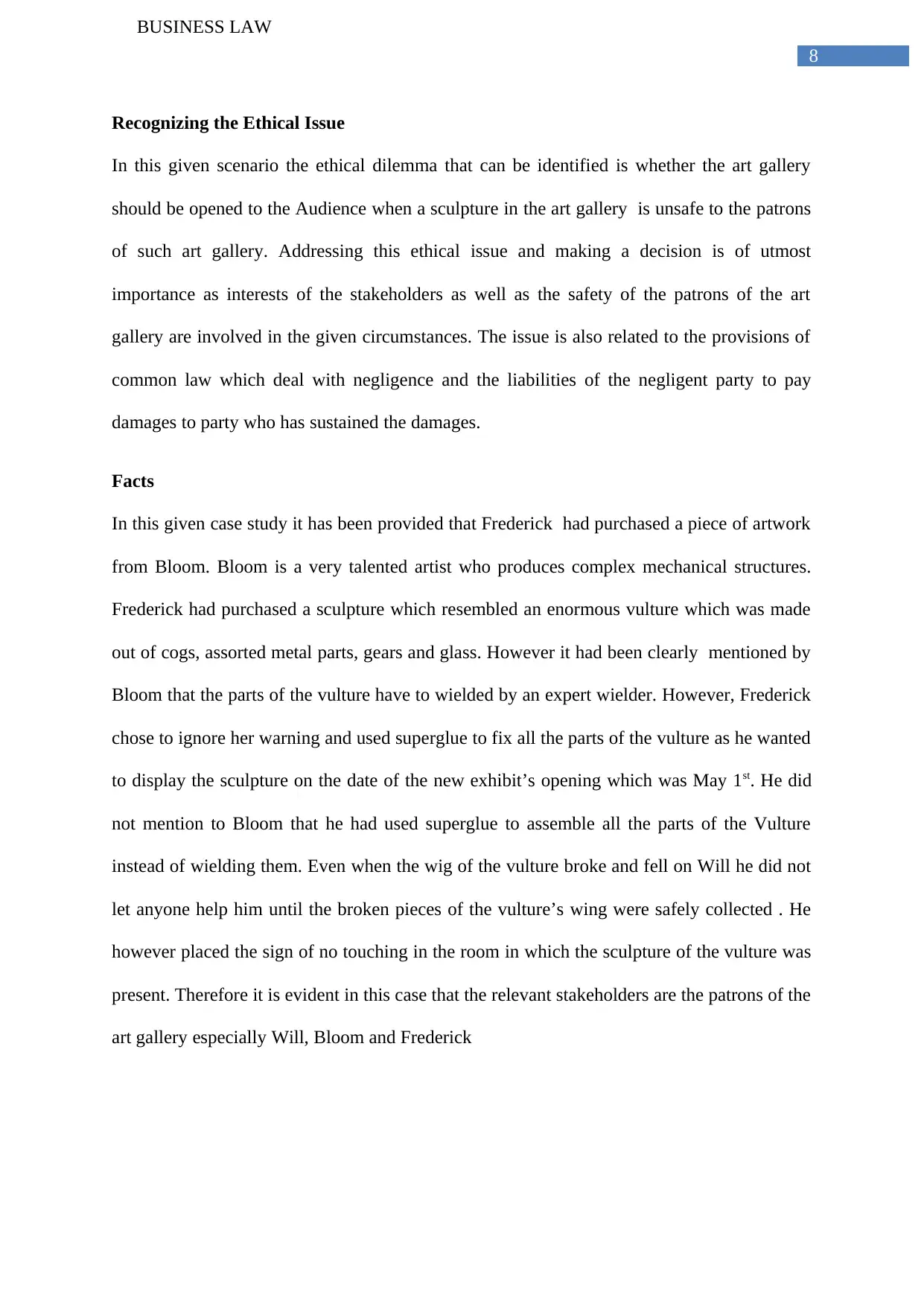
8
BUSINESS LAW
Recognizing the Ethical Issue
In this given scenario the ethical dilemma that can be identified is whether the art gallery
should be opened to the Audience when a sculpture in the art gallery is unsafe to the patrons
of such art gallery. Addressing this ethical issue and making a decision is of utmost
importance as interests of the stakeholders as well as the safety of the patrons of the art
gallery are involved in the given circumstances. The issue is also related to the provisions of
common law which deal with negligence and the liabilities of the negligent party to pay
damages to party who has sustained the damages.
Facts
In this given case study it has been provided that Frederick had purchased a piece of artwork
from Bloom. Bloom is a very talented artist who produces complex mechanical structures.
Frederick had purchased a sculpture which resembled an enormous vulture which was made
out of cogs, assorted metal parts, gears and glass. However it had been clearly mentioned by
Bloom that the parts of the vulture have to wielded by an expert wielder. However, Frederick
chose to ignore her warning and used superglue to fix all the parts of the vulture as he wanted
to display the sculpture on the date of the new exhibit’s opening which was May 1st. He did
not mention to Bloom that he had used superglue to assemble all the parts of the Vulture
instead of wielding them. Even when the wig of the vulture broke and fell on Will he did not
let anyone help him until the broken pieces of the vulture’s wing were safely collected . He
however placed the sign of no touching in the room in which the sculpture of the vulture was
present. Therefore it is evident in this case that the relevant stakeholders are the patrons of the
art gallery especially Will, Bloom and Frederick
BUSINESS LAW
Recognizing the Ethical Issue
In this given scenario the ethical dilemma that can be identified is whether the art gallery
should be opened to the Audience when a sculpture in the art gallery is unsafe to the patrons
of such art gallery. Addressing this ethical issue and making a decision is of utmost
importance as interests of the stakeholders as well as the safety of the patrons of the art
gallery are involved in the given circumstances. The issue is also related to the provisions of
common law which deal with negligence and the liabilities of the negligent party to pay
damages to party who has sustained the damages.
Facts
In this given case study it has been provided that Frederick had purchased a piece of artwork
from Bloom. Bloom is a very talented artist who produces complex mechanical structures.
Frederick had purchased a sculpture which resembled an enormous vulture which was made
out of cogs, assorted metal parts, gears and glass. However it had been clearly mentioned by
Bloom that the parts of the vulture have to wielded by an expert wielder. However, Frederick
chose to ignore her warning and used superglue to fix all the parts of the vulture as he wanted
to display the sculpture on the date of the new exhibit’s opening which was May 1st. He did
not mention to Bloom that he had used superglue to assemble all the parts of the Vulture
instead of wielding them. Even when the wig of the vulture broke and fell on Will he did not
let anyone help him until the broken pieces of the vulture’s wing were safely collected . He
however placed the sign of no touching in the room in which the sculpture of the vulture was
present. Therefore it is evident in this case that the relevant stakeholders are the patrons of the
art gallery especially Will, Bloom and Frederick
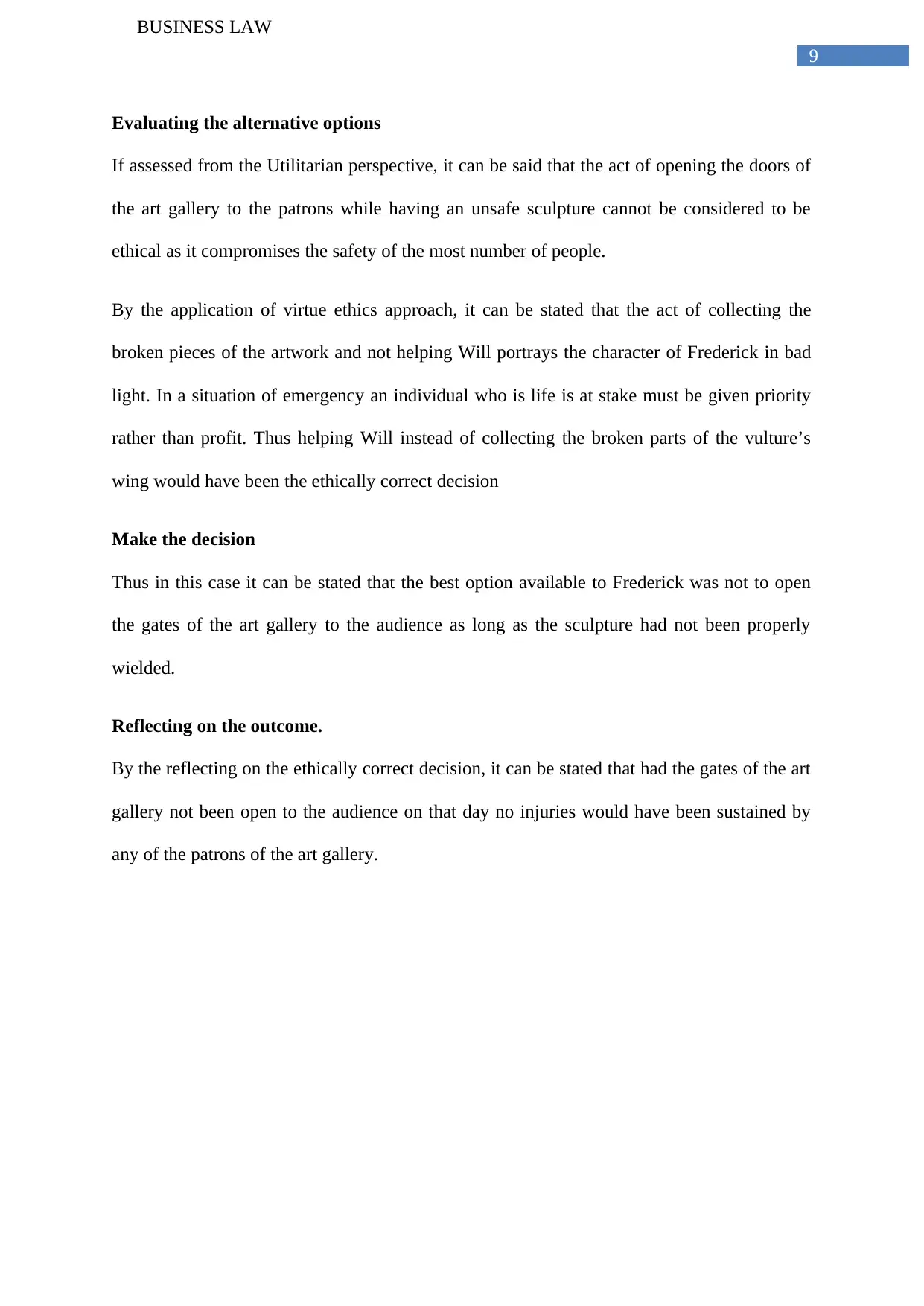
9
BUSINESS LAW
Evaluating the alternative options
If assessed from the Utilitarian perspective, it can be said that the act of opening the doors of
the art gallery to the patrons while having an unsafe sculpture cannot be considered to be
ethical as it compromises the safety of the most number of people.
By the application of virtue ethics approach, it can be stated that the act of collecting the
broken pieces of the artwork and not helping Will portrays the character of Frederick in bad
light. In a situation of emergency an individual who is life is at stake must be given priority
rather than profit. Thus helping Will instead of collecting the broken parts of the vulture’s
wing would have been the ethically correct decision
Make the decision
Thus in this case it can be stated that the best option available to Frederick was not to open
the gates of the art gallery to the audience as long as the sculpture had not been properly
wielded.
Reflecting on the outcome.
By the reflecting on the ethically correct decision, it can be stated that had the gates of the art
gallery not been open to the audience on that day no injuries would have been sustained by
any of the patrons of the art gallery.
BUSINESS LAW
Evaluating the alternative options
If assessed from the Utilitarian perspective, it can be said that the act of opening the doors of
the art gallery to the patrons while having an unsafe sculpture cannot be considered to be
ethical as it compromises the safety of the most number of people.
By the application of virtue ethics approach, it can be stated that the act of collecting the
broken pieces of the artwork and not helping Will portrays the character of Frederick in bad
light. In a situation of emergency an individual who is life is at stake must be given priority
rather than profit. Thus helping Will instead of collecting the broken parts of the vulture’s
wing would have been the ethically correct decision
Make the decision
Thus in this case it can be stated that the best option available to Frederick was not to open
the gates of the art gallery to the audience as long as the sculpture had not been properly
wielded.
Reflecting on the outcome.
By the reflecting on the ethically correct decision, it can be stated that had the gates of the art
gallery not been open to the audience on that day no injuries would have been sustained by
any of the patrons of the art gallery.
Secure Best Marks with AI Grader
Need help grading? Try our AI Grader for instant feedback on your assignments.
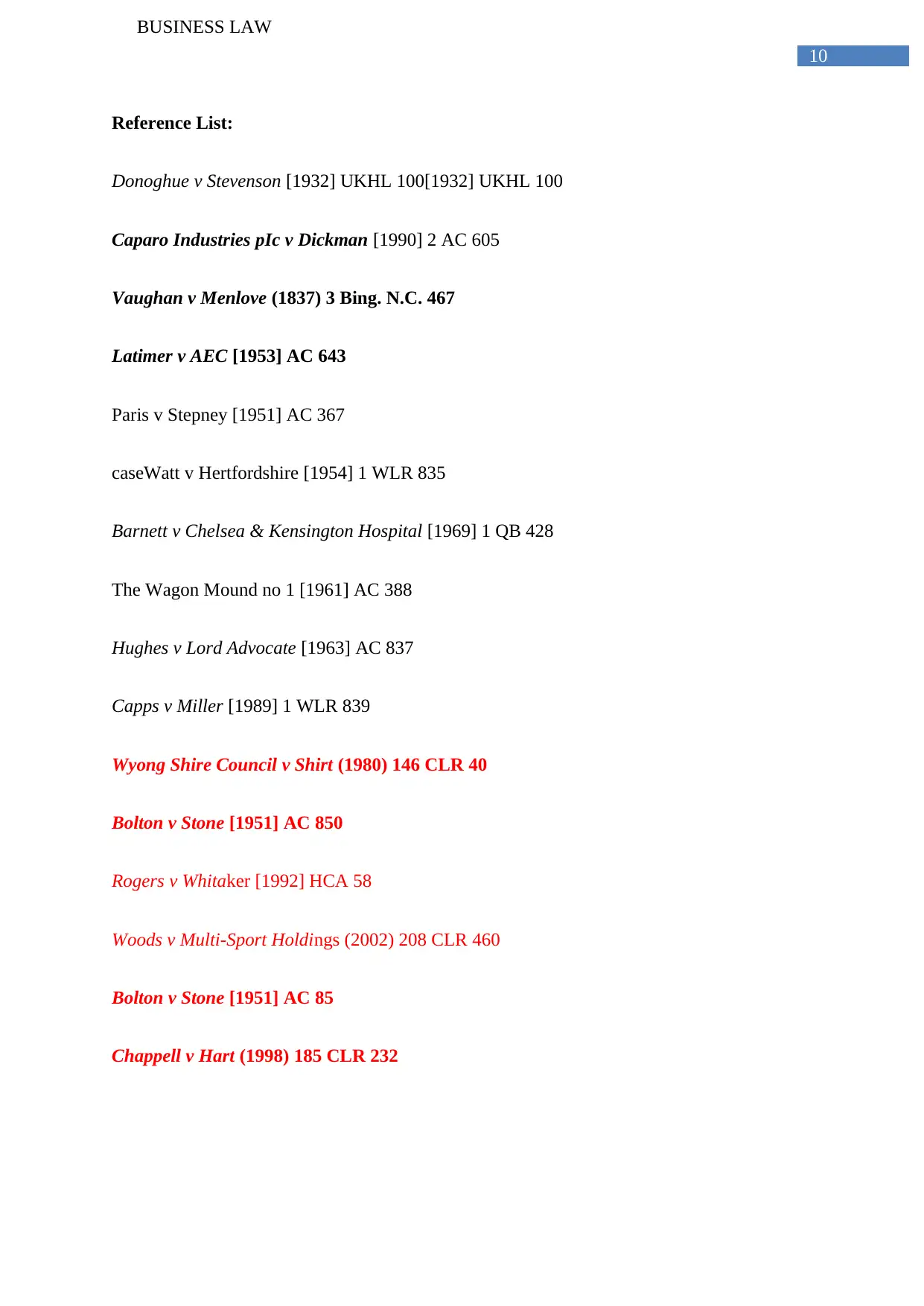
10
BUSINESS LAW
Reference List:
Donoghue v Stevenson [1932] UKHL 100[1932] UKHL 100
Caparo Industries pIc v Dickman [1990] 2 AC 605
Vaughan v Menlove (1837) 3 Bing. N.C. 467
Latimer v AEC [1953] AC 643
Paris v Stepney [1951] AC 367
caseWatt v Hertfordshire [1954] 1 WLR 835
Barnett v Chelsea & Kensington Hospital [1969] 1 QB 428
The Wagon Mound no 1 [1961] AC 388
Hughes v Lord Advocate [1963] AC 837
Capps v Miller [1989] 1 WLR 839
Wyong Shire Council v Shirt (1980) 146 CLR 40
Bolton v Stone [1951] AC 850
Rogers v Whitaker [1992] HCA 58
Woods v Multi-Sport Holdings (2002) 208 CLR 460
Bolton v Stone [1951] AC 85
Chappell v Hart (1998) 185 CLR 232
BUSINESS LAW
Reference List:
Donoghue v Stevenson [1932] UKHL 100[1932] UKHL 100
Caparo Industries pIc v Dickman [1990] 2 AC 605
Vaughan v Menlove (1837) 3 Bing. N.C. 467
Latimer v AEC [1953] AC 643
Paris v Stepney [1951] AC 367
caseWatt v Hertfordshire [1954] 1 WLR 835
Barnett v Chelsea & Kensington Hospital [1969] 1 QB 428
The Wagon Mound no 1 [1961] AC 388
Hughes v Lord Advocate [1963] AC 837
Capps v Miller [1989] 1 WLR 839
Wyong Shire Council v Shirt (1980) 146 CLR 40
Bolton v Stone [1951] AC 850
Rogers v Whitaker [1992] HCA 58
Woods v Multi-Sport Holdings (2002) 208 CLR 460
Bolton v Stone [1951] AC 85
Chappell v Hart (1998) 185 CLR 232
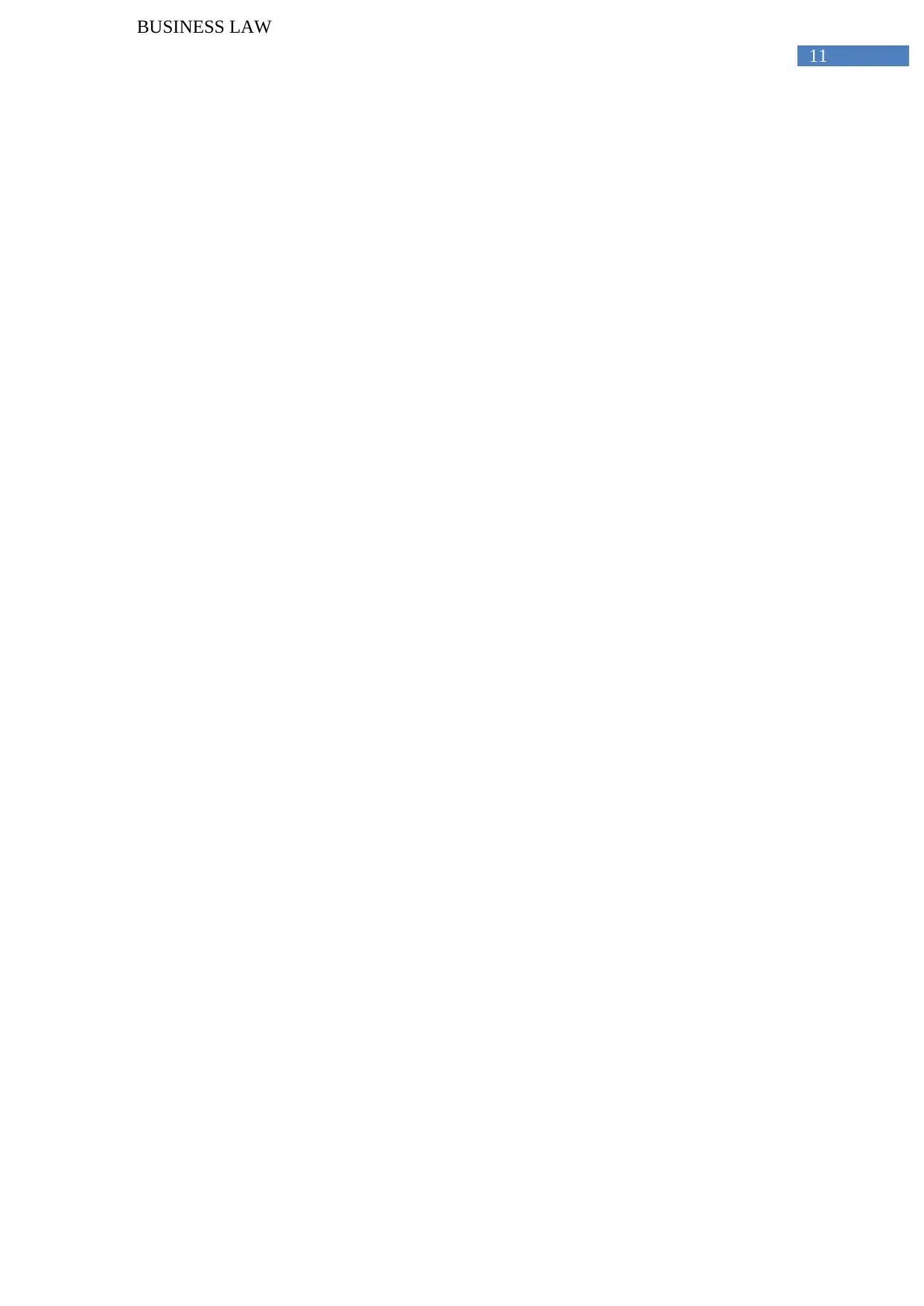
11
BUSINESS LAW
BUSINESS LAW
1 out of 12
Related Documents
Your All-in-One AI-Powered Toolkit for Academic Success.
+13062052269
info@desklib.com
Available 24*7 on WhatsApp / Email
![[object Object]](/_next/static/media/star-bottom.7253800d.svg)
Unlock your academic potential
© 2024 | Zucol Services PVT LTD | All rights reserved.





